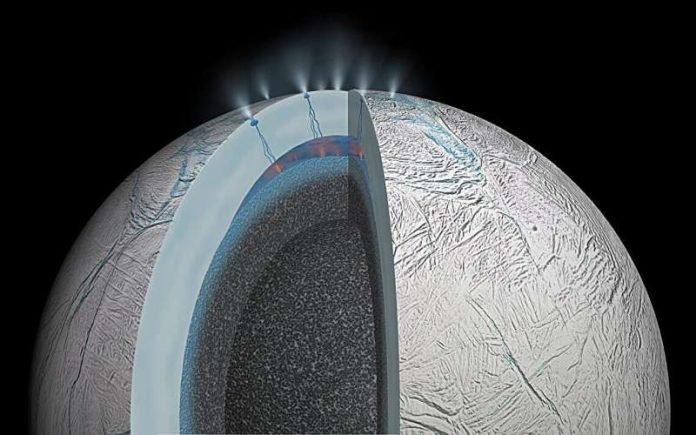
In the vastness of our solar system, the icy moons orbiting Saturn and Jupiter stand out as potential hideouts for alien life.
These frozen worlds, with oceans hidden beneath thick ice shells, have long fascinated scientists.
A new study by a team from the University of Washington in Seattle and Freie Universität Berlin has brought us one step closer to uncovering the secrets these icy moons hold.
This study, shared with the world through Science Advances, reveals an innovative way to hunt for signs of life in space. Imagine tiny grains of ice, flung into the void from the surfaces of moons like Enceladus or Europa, carrying within them the potential evidence of life.
The researchers have discovered that even a minuscule amount of material from these ice grains might hold the key to detecting life forms.
Fabian Klenner, a postdoctoral researcher and the study’s lead author, explains their milestone achievement.
They’ve shown that spacecraft instruments, even those launching soon, could identify signs of life in these tiny ice particles.
This breakthrough boosts our confidence in finding life beyond Earth, possibly on the ocean-bearing moons of our solar system.
The Cassini mission, which ended its journey in 2017, gave us a glimpse into this possibility. It observed plumes of gas and ice shooting out from cracks near Enceladus’s south pole.
These emissions suggest that beneath the icy exterior, there might be oceans warm enough to harbor life. The upcoming Europa Clipper mission aims to explore similar mysteries on Europa, one of Jupiter’s moons, with more sophisticated tools.
However, simulating the conditions these ice grains experience in space presents a challenge. The team couldn’t recreate the grains’ high-speed journey through space to an observing instrument.
Instead, they took a creative approach by using a beam of liquid water in a vacuum, breaking it into droplets. They then excited these droplets with a laser, analyzing them with techniques similar to what space probes like the Europa Clipper will use.
Their findings are promising. The instruments on these future missions could detect the presence of cellular material in a fraction of the ice grains they encounter. This would be a monumental step in the search for extraterrestrial life.
The study specifically looked at Sphingopyxis alaskensis, a bacterium thriving in cold, nutrient-poor waters, making it an ideal candidate for life on icy moons.
This tiny organism could potentially live in the extreme conditions of Enceladus or Europa, encapsulated within ice grains that are then ejected into space.
The discovery that these instruments can identify bacterial material in single ice grains is significant.
It means that analyzing these grains individually could be more effective than examining larger samples. This method could concentrate the biomaterial, making it easier to detect.
Encouragingly, recent research has found signs of phosphate on Enceladus, adding to the list of life-supporting ingredients believed to be present on these moons.
This includes energy sources, water, salts, and organic materials, increasing the likelihood that these icy worlds could sustain life.
The scenario the researchers propose is fascinating. They suggest that if microbial life exists in the oceans beneath the ice, it could become trapped in the ice grains that form from ocean water.
These grains, when ejected into space through plumes, could carry the signs of life, waiting to be discovered by missions like the Europa Clipper.
This study not only advances our understanding of where and how to look for signs of life beyond Earth but also opens new avenues for future explorations.
With improved instruments capable of detecting even the smallest signs of life, the dream of finding extraterrestrial life within our solar system is closer than ever.
The research findings can be found in Science Advances.
Copyright © 2024 Knowridge Science Report. All rights reserved.



